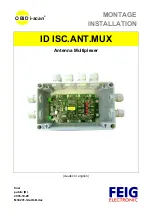
E • Prueba de continuidad
❶
Ponga el selector de función en la posición
.
❷
Conecte la punta
de prueba negra a la entrada -Rx (negra) y toque uno de los puntos de
contacto con el extremo.
❸
Conecte la punta de prueba roja a la eRx
(roja) y toque el otro punto de contacto con el extremo (vea las conexiones
en la Fig. 1).
❹
El zumbador interno emite un tono cuando la resistencia es
menor de aproximadamente 100
Ω
.
F • Test de Continuité
❶
Placez le sélecteur sur
.
❷
Connectez le cordon rouge à l’entrée
+Rx (rouge) et le cordon noir à l’entrée -Rx.
❸
Connectez les pointes de
touche au circuit.
❹
Un signal sonore retentit pour R
≤
100
Ω
.
CAPACITANCE MEASUREMENTS (Fig. 3)
Discharge all voltage from the capacitor (via a 100k
Ω
resistor) before
measuring its value.
❶
Connect the red test lead to the Cx+ input and the black
test lead to the Cx– input.
❷
Set the function/range switch to the capacitance
range that gives the best resolution.
❸
Apply probe tips to the capacitor leads.
When measuring electrolytic capacitors, observe correct polarity.
❹
Read the
capacitance value on the display (you may have to wait a few seconds until the
capacitor is fully charged). If “OL” appears in the highest range, the capacitor
is too large to be measured.
Note 1:
For small value measurements utilize CAP Zero Adjust to eliminate
test lead capacitance (±20pF).
Note 2 :
Small value capacitors can also be measured by inserting their leads
directly into the slots in the meter.
D • Kapazitätsmessung (siehe Fig. 3)
Kondensator entladen (über 100k
Ω
Widerstand).
❶
Rotes Meßkabel mit
Cx+ Eingang und schwarzes mit Cx- Eingang verbinden.
❷
Wahlschalter
auf den Kapazitätsbereich stellen der die beste Auflösung gibt.
❸
Meßspitzen mit Kondensatorleitern verbinden. Bei elektrolytischen
Kondensatoren, Polarität beachten.
❹
Meßwert ablesen (Sie müssen
vielleicht einige Sekunden warten bis der Kondensator ganz aufgeladen ist).
– 13 –
CR50.Man.07.00 11/30/00 6:16 PM Page 14















































